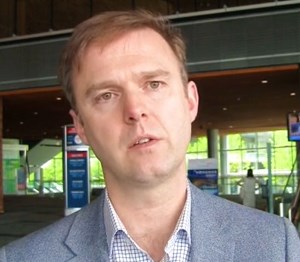User login
VANCOUVER – To define the top 10 research priorities in endometriosis, researchers at the University of Edinburgh, Scotland, and their colleagues did something unusual in the world of medical science. They asked the women who have the disease.
More than 70% of the 1,225 people initially surveyed to define what most needs to be figured out in endometriosis were patients, and most of the rest were clinicians who take care of them. Patients were involved throughout an exhaustive process that whittled down nearly 5,000 initial suggestions to a list of 10 priorities.
The first priority is to determine if endometriosis can be cured, and the second task is to find its cause (Lancet. 2017 May 18. doi: 10.1016/S0140-6736(17)31344-2).
Women who have endometriosis said they want a noninvasive diagnostic test. They also want help managing the emotional and physical impacts of living with the disease, not simply treatments that focus on lesions, according to Andrew Horne, MBChB, PhD, a professor of gynecology and reproductive sciences at the University of Edinburgh, who led the efforts.
In an interview at the World Congress on Endometriosis, Dr. Horne explained why it’s critical to define the top research priorities and what doing so could mean for patients and doctors. He also explained the importance of a recent insight into the pathogenesis of endometriosis: It behaves like cancer.
The video associated with this article is no longer available on this site. Please view all of our videos on the MDedge YouTube channel
VANCOUVER – To define the top 10 research priorities in endometriosis, researchers at the University of Edinburgh, Scotland, and their colleagues did something unusual in the world of medical science. They asked the women who have the disease.
More than 70% of the 1,225 people initially surveyed to define what most needs to be figured out in endometriosis were patients, and most of the rest were clinicians who take care of them. Patients were involved throughout an exhaustive process that whittled down nearly 5,000 initial suggestions to a list of 10 priorities.
The first priority is to determine if endometriosis can be cured, and the second task is to find its cause (Lancet. 2017 May 18. doi: 10.1016/S0140-6736(17)31344-2).
Women who have endometriosis said they want a noninvasive diagnostic test. They also want help managing the emotional and physical impacts of living with the disease, not simply treatments that focus on lesions, according to Andrew Horne, MBChB, PhD, a professor of gynecology and reproductive sciences at the University of Edinburgh, who led the efforts.
In an interview at the World Congress on Endometriosis, Dr. Horne explained why it’s critical to define the top research priorities and what doing so could mean for patients and doctors. He also explained the importance of a recent insight into the pathogenesis of endometriosis: It behaves like cancer.
The video associated with this article is no longer available on this site. Please view all of our videos on the MDedge YouTube channel
VANCOUVER – To define the top 10 research priorities in endometriosis, researchers at the University of Edinburgh, Scotland, and their colleagues did something unusual in the world of medical science. They asked the women who have the disease.
More than 70% of the 1,225 people initially surveyed to define what most needs to be figured out in endometriosis were patients, and most of the rest were clinicians who take care of them. Patients were involved throughout an exhaustive process that whittled down nearly 5,000 initial suggestions to a list of 10 priorities.
The first priority is to determine if endometriosis can be cured, and the second task is to find its cause (Lancet. 2017 May 18. doi: 10.1016/S0140-6736(17)31344-2).
Women who have endometriosis said they want a noninvasive diagnostic test. They also want help managing the emotional and physical impacts of living with the disease, not simply treatments that focus on lesions, according to Andrew Horne, MBChB, PhD, a professor of gynecology and reproductive sciences at the University of Edinburgh, who led the efforts.
In an interview at the World Congress on Endometriosis, Dr. Horne explained why it’s critical to define the top research priorities and what doing so could mean for patients and doctors. He also explained the importance of a recent insight into the pathogenesis of endometriosis: It behaves like cancer.
The video associated with this article is no longer available on this site. Please view all of our videos on the MDedge YouTube channel
AT WCE 2017
